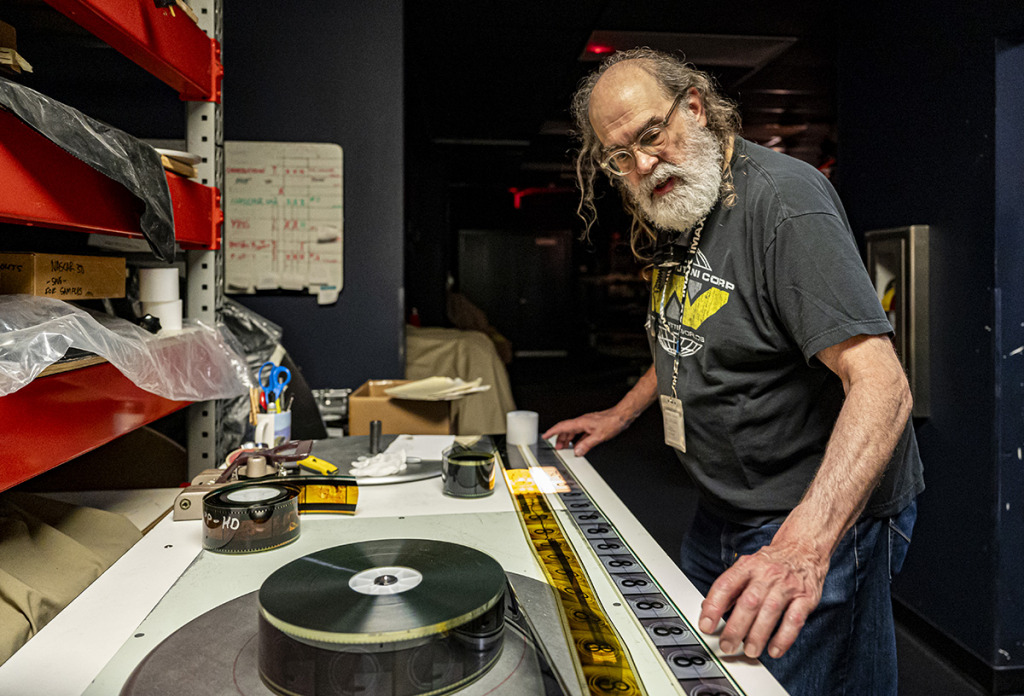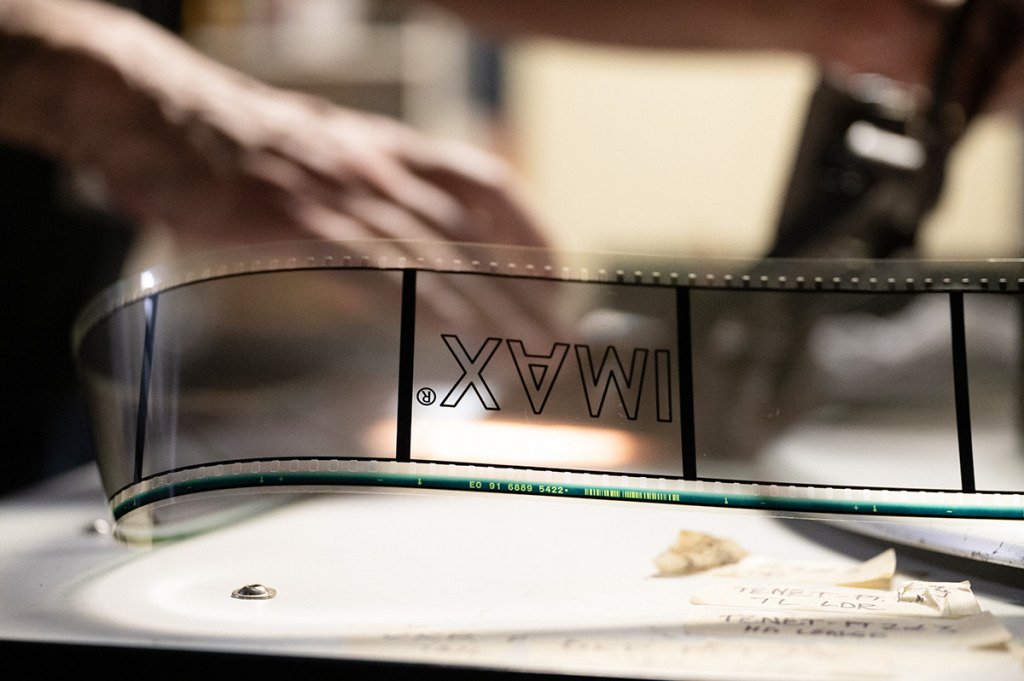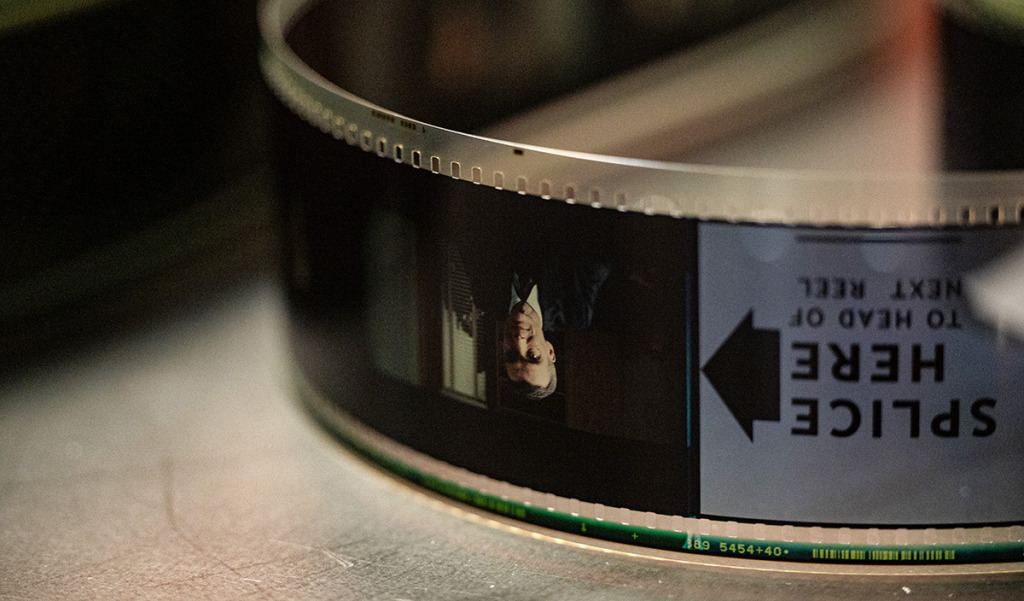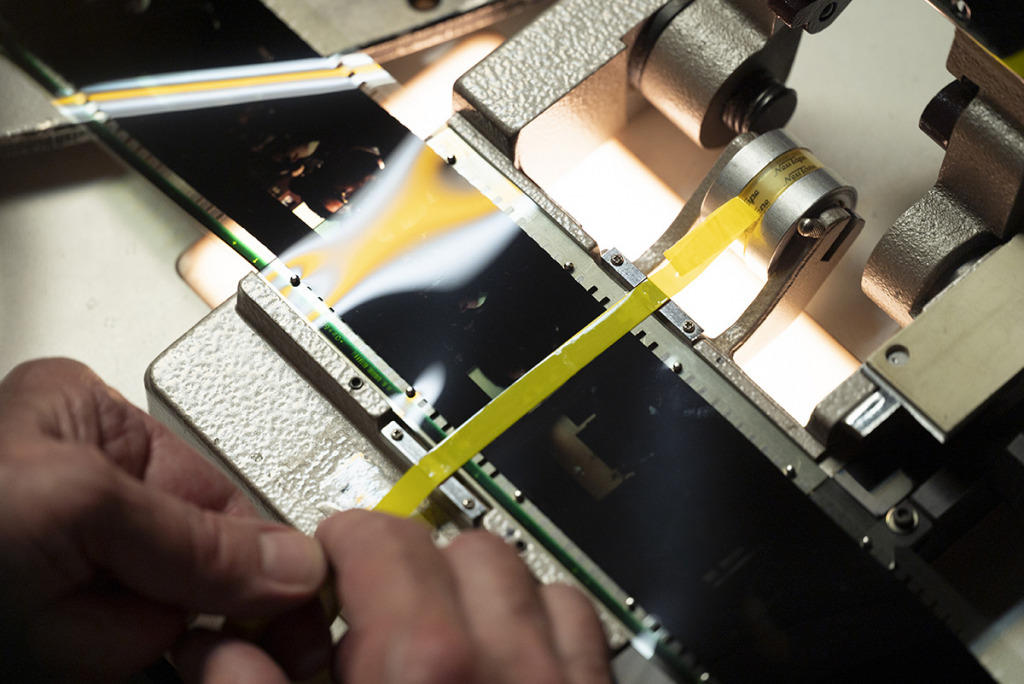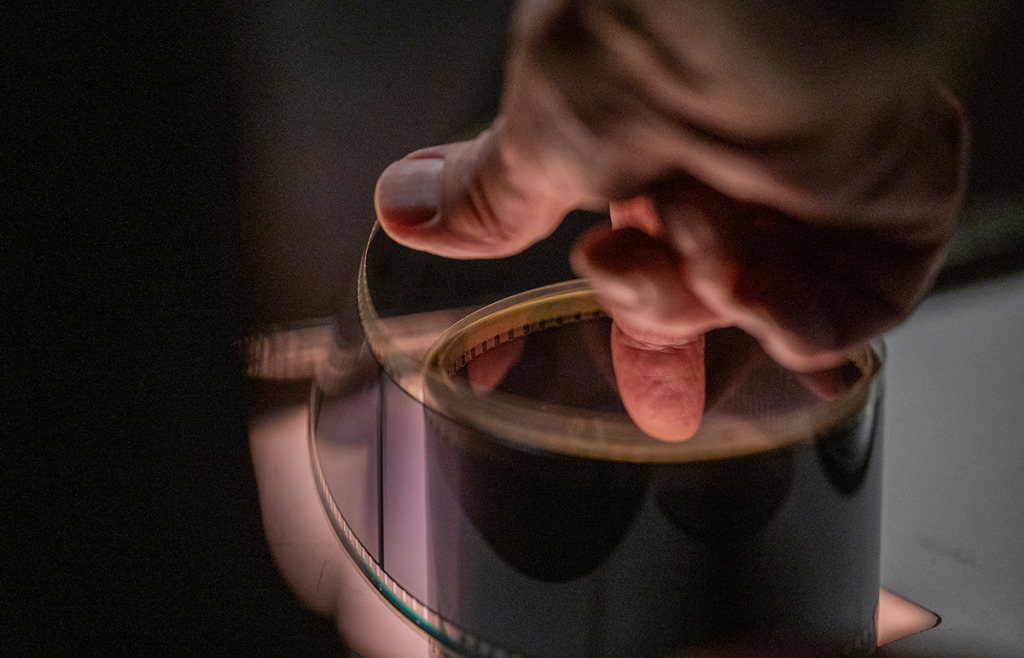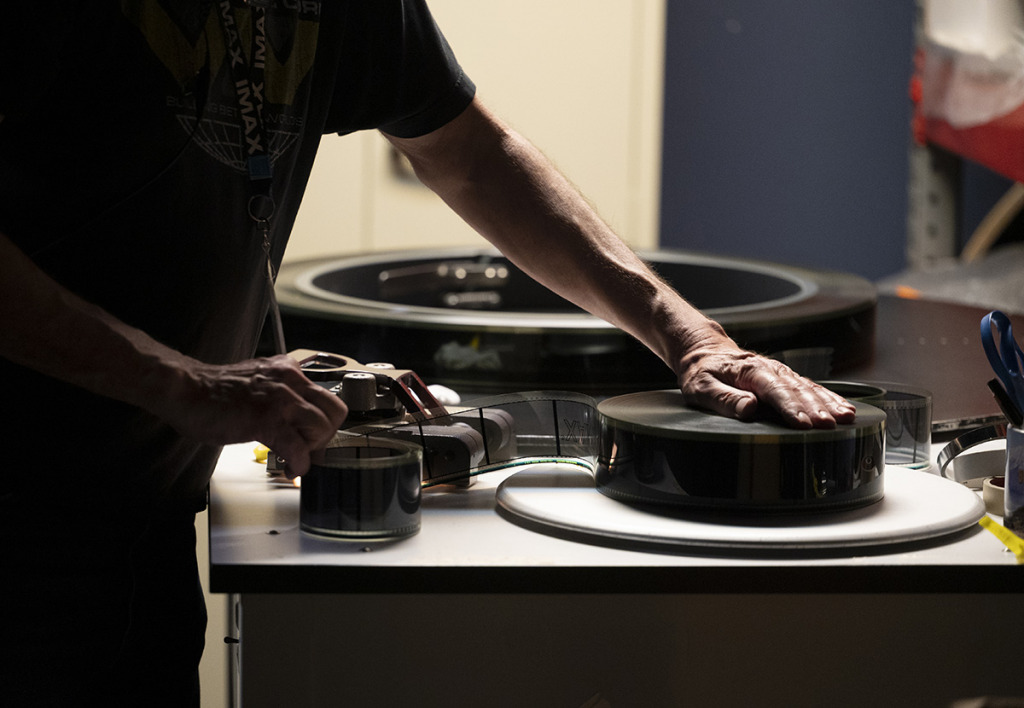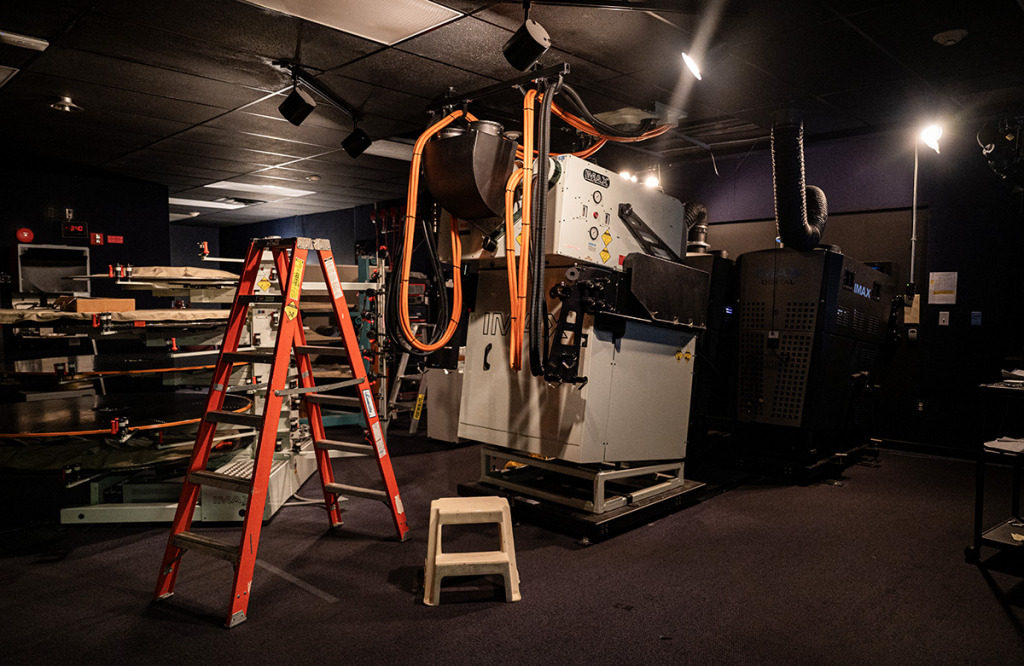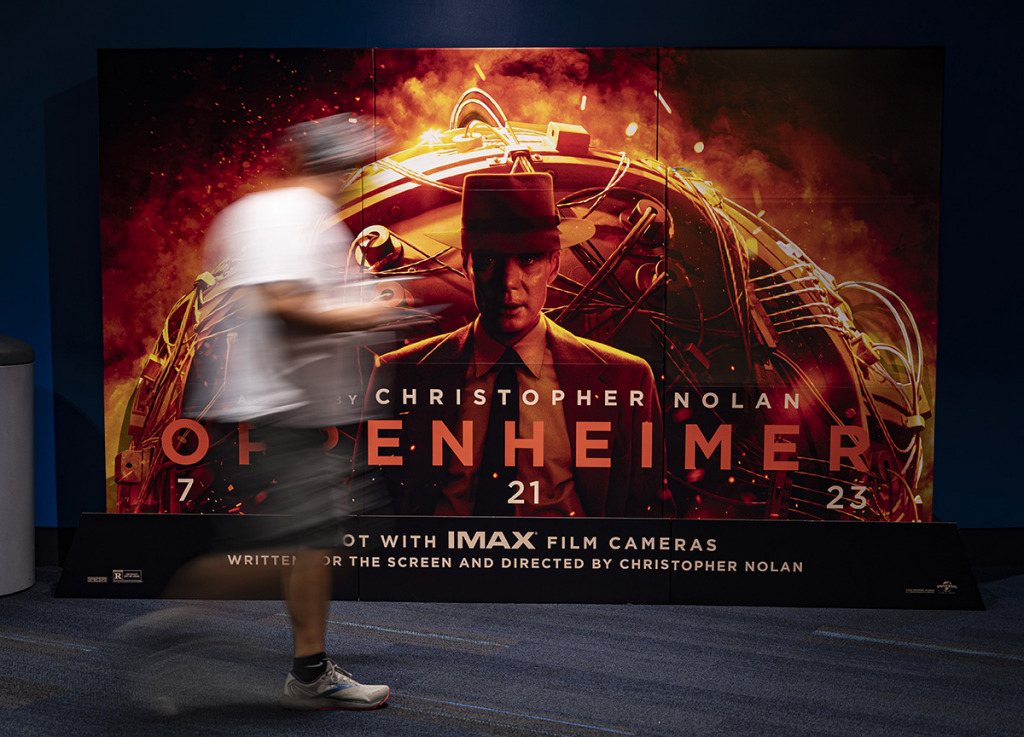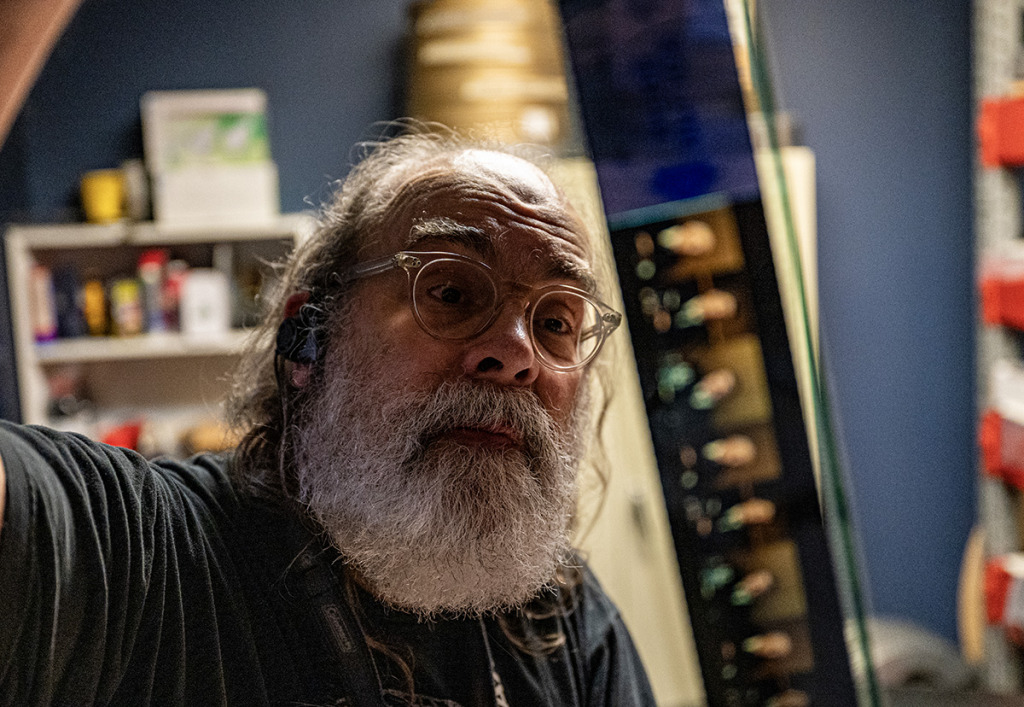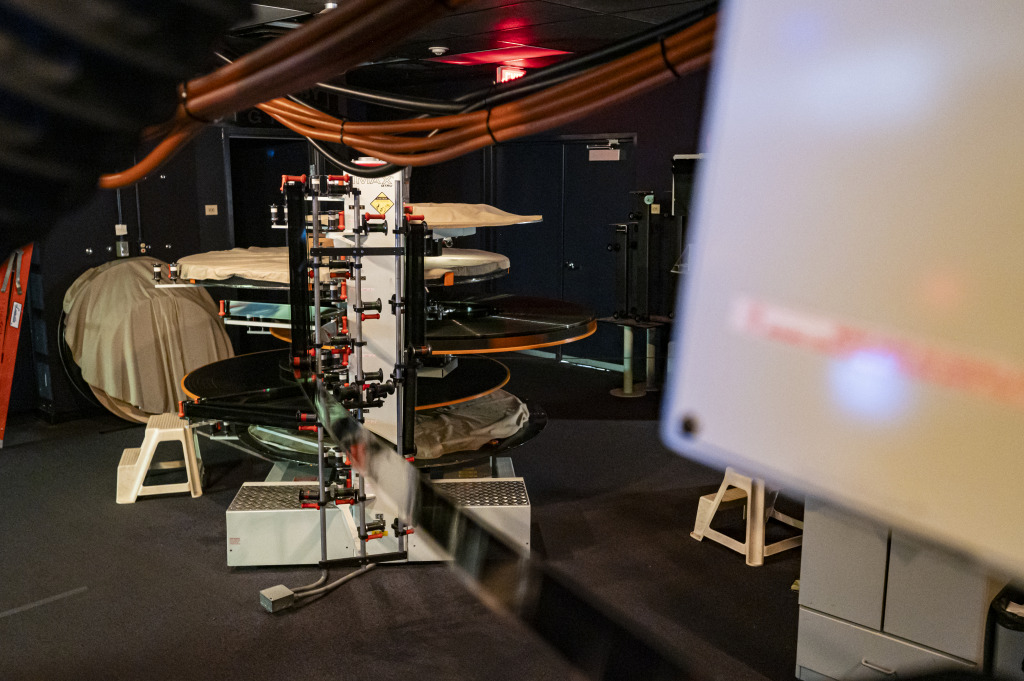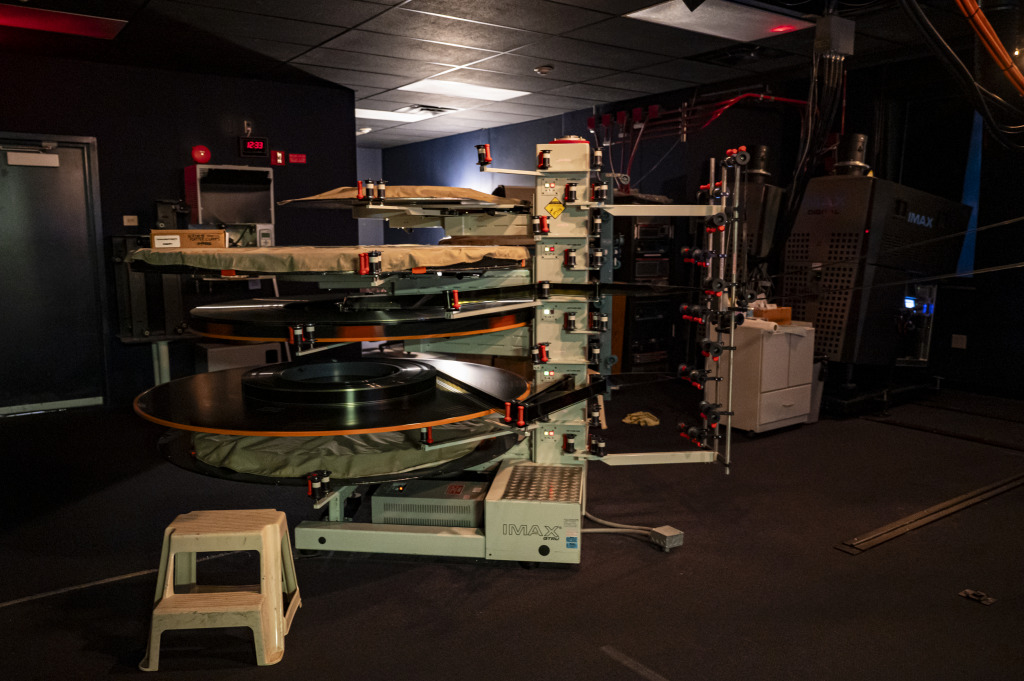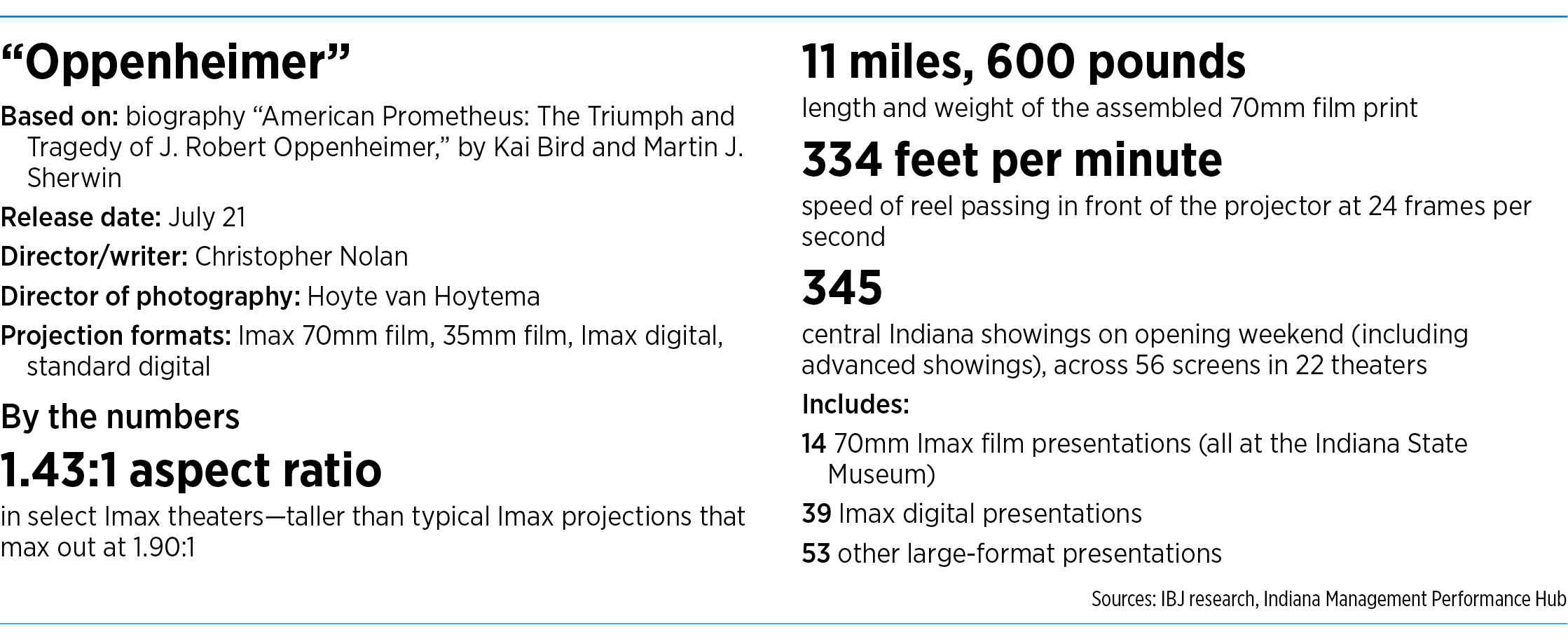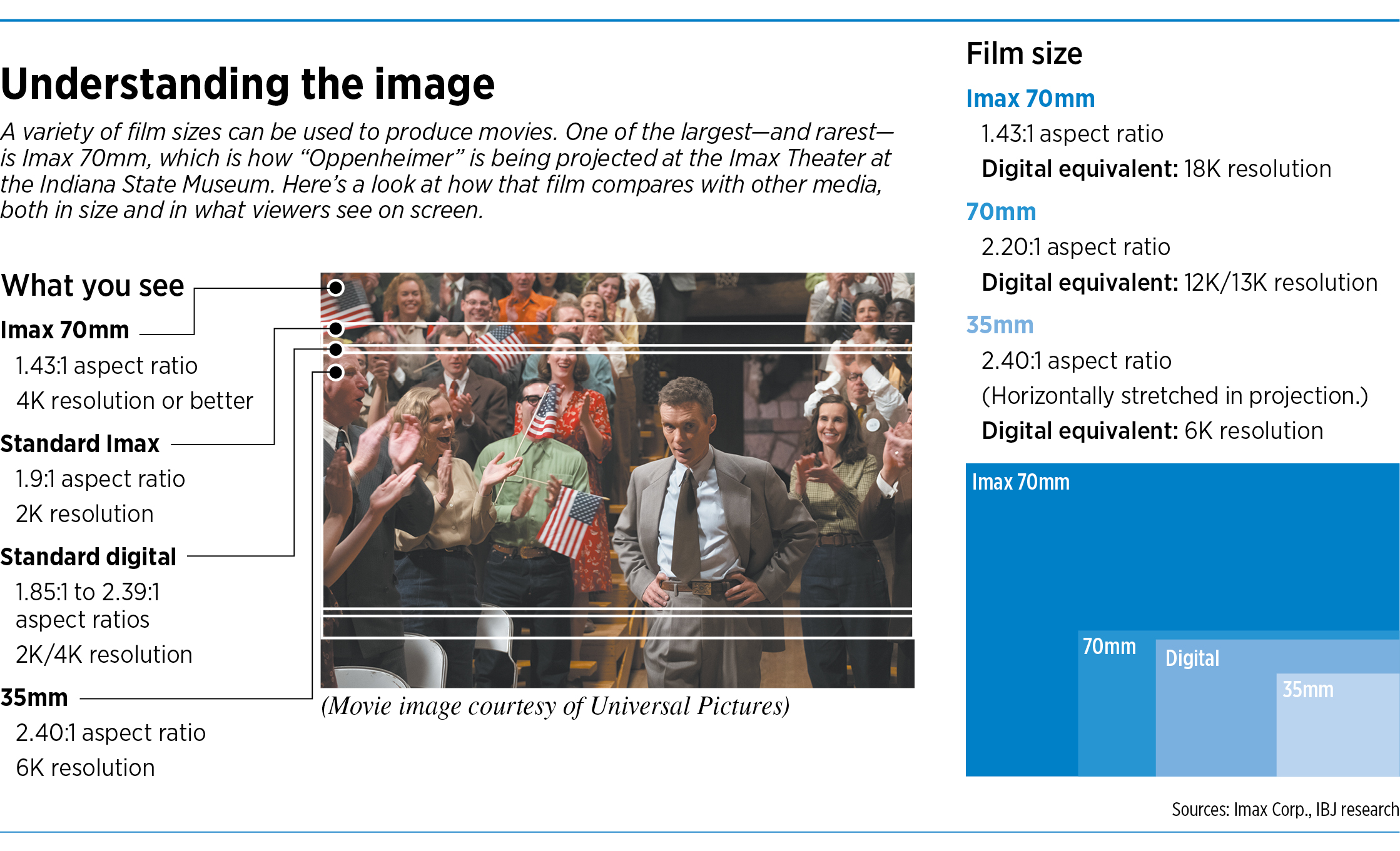Subscriber Benefit
As a subscriber you can listen to articles at work, in the car, or while you work out. Subscribe NowAfter nearly 20 years of working in the projection booth at the Indiana State Museum’s Imax theater, Wayne Indyk has helped showcase hundreds of films on the state’s largest movie screen—but never one quite so elaborate as “Oppenheimer.”
Released Friday, the Christopher Nolan-directed movie focuses on the life of physicist J. Robert Oppenheimer and his team’s assembly of the first nuclear weapon during World War II. The movie was shot with massive screens like the Indianapolis Imax in mind by using 65mm Imax and Panavision cameras, considered top-notch for film quality.
Few screens anywhere can match the scale of what the museum presents.
But unlike the digital projection of many movies today, “Oppenheimer” at the museum will be shown from actual film—another facet that makes the museum’s experience stand out. At three hours and 30 seconds in length, this is the longest Imax-film-format production Indyk has ever cut together.
The task took the theater’s chief projectionist three days to complete. He assembled more than 260,000 frames across 53 reels—altogether weighing more than 600 pounds—onto a single film holder, or platter, for use in a special projector found in only 29 other theaters in the world. The platter itself had to be extended from its standard 6-foot width to accommodate the film, which is 11 miles long from the first to last frame.
“It’s all a process from when they’re making the film—shooting it, developing it, printing it, mixing it. There are all these little steps that have to come together,” Indyk said, noting that the theater has showcased other 70mm films—including several directed by Nolan, such as “Dunkirk” and “Interstellar.”
“With these films, I’ve got to physically put things together and [set up] the presentation. That whole sequence is kind of amazing, because it’s all manual,” Indyk said. “But then there’s the magic that happens on the screen.”
With each reel, Indyk is responsible for ensuring that the film is spliced in exactly the right spot or else he risks disrupting the viewing experience. It’s a measure-twice, cut-once kind of gig, he said, and one he acknowledges is still nerve-racking even after 30 years in the business. The process went exactly according to plan for “Oppenheimer,” with no missed cuts.
“You want to make that cut smooth—and there have been times when I’ve missed it,” he said. Anytime that happens, he added, it’s critical to add two black frames to the reel to prevent the film and sound from getting out of sync.
The sound adds to the challenge. It is played through a DVD, which is synced up to the projector digitally starting with a specific frame. Any missing frames throughout the film result in a sound problem.
“You try not to let [errors] get to you, because you’ve got to go on and keep working,” Indyk said. “You have to spend a lot of time with a film to bring it all together, so you don’t have the time to cry over spilled milk.”
Setting the stage
The single-screen Imax theater, owned by the state of Indiana and operated by Toronto-based Imax Corp., opened in December 1996 as a stand-alone facility. Six years later, when the Indiana State Museum opened, it engulfed the Imax building into its own footprint.
The theater generally shows educational programming shot on Imax cameras—think 30-minute to hour-long nature documentaries—in the morning and early afternoon before switching to the latest Hollywood releases.
During its three-week run, the Nolan film is expected to be the only thing that illuminates the screen. That’s because it takes an hour to change between the standard digital projection system and the 70mm film project used to display “Oppenheimer.”
Hollywood releases contribute far more to the theater’s earnings than the educational screenings do, so switching between the systems each day wouldn’t be financially prudent.
“Oppenheimer” is expected to screen tens of thousands of times in theaters globally in the coming weeks, but only a fraction of those are planned for Imax 70mm film theaters—the format Nolan himself said is the best way to experience the film.
What sets the Indianapolis Imax apart from most theaters is its sheer size, with a six-story, 84-foot by 62-foot display. It’s also the only theater in the state—and one of just a few in the Midwest—capable of showcasing the film as Nolan intended, both in terms of its aspect ratio and its projection format: film. The museum theater is one of 30 worldwide capable of showing the movie in that format.
Multiplexes in Indianapolis have shifted to all-digital projection; the older 35mm film projection can still be found at venues like the Historic Artcraft Theatre in Franklin. While the Indianapolis Imax also projects almost exclusively digitally, it has retained its 70mm Imax film projector for specialty screenings.
In central Indiana, 345 screenings are expected in the first four days of the release of “Oppenheimer,” including those at the state museum, along with 39 in standard Imax digital projection at local AMC theaters and 53 more slated for other large-format screens.
Cashing in
For the Indiana State Museum theater, in particular, “Oppenheimer” means big business.
As of Monday, most of the venue’s opening weekend screenings were at or near capacity, with more than 1,000 visitors expected each day.
In fact, the film is already on track to be among the theater’s top Hollywood movies in the post-pandemic era—putting it ahead of “Top Gun: Maverick” and “Spider-Man: No Way Home” in ticket sales through only its first weekend, said Neale Johantgen, the theater’s director. The theater also has shown films like “Black Panther: Wakanda Forever” and “Avatar: The Way of Water” in the past two years, the latter of which ran for nine weeks.
An IBJ analysis based on ticket prices found the theater could bring in nearly $100,000 in revenue from ticket sales alone during opening weekend, though most of that money will go back to Imax Corp. and Los Angeles-based distributor Universal Pictures. The movie could bring tens of thousands of dollars in concession sales, as well.
Tickets to “Oppenheimer” at the museum theater cost $20 for adults and $17 for children ages 12 and under, a premium from the $16.50 typically charged. The theater also charges a $2.50 processing fee for online orders.
“It’s just a different experience” from what audiences in standard theaters will have, Johantgen said. “We make a lot of [our] money off ticket sales, especially when it’s a movie like this. But concessions are very important to how we do business, too. I think we’ve kept prices reasonable, while it’s still at a place where we’re doing some good business.”
The Indianapolis Imax sources concession offerings from several area companies, including Indianapolis-based Sun King, Metazoa Brewing Co., Guggman Haus Brewing Co., Hi & Mighty Distillery, Big Lug Canteen and Bloomington-based Cardinal Spirits. In addition to its more traditional snacks, the theater also offers selections from Merrillville-based Albanese Candy.
In conjunction with the release of “Oppenheimer,” the theater plans to offer several themed promotions, including a Manhattan made with Hotel Tango whiskey, a film strip giveaway, and a collaboration with Indy Reads focused on film adaptations from books, which will run through the end of the year.
Jake Oakman, executive director of the White River State Park complex, said the theater is one of the three largest sources of revenue for the campus, alongside the TCU Amphitheater and the parking garage. Specific revenue figures were not available by the time of publication.
“I think the one-screen theater format actually gives us a bit of a competitive advantage,” he said. “When people look at us, they know we’re going to play the biggest movie that’s out that week and maybe the next, and then it’s going to change. It creates a little sense of urgency for those who want to experience a film here to get out and do it.”
A big push
Christopher Lloyd, a film critic with WXIN-TV Channel 59 and local publication Film Yap, has been reviewing movies more than 30 years. He said the experience of watching films at the Indiana State Museum Imax theater is “incomparable,” particularly when it comes to films like “Oppenheimer” that are shot with venues like the museum’s theater in mind from the beginning.
“You feel surrounded by the film and part of it,” he told IBJ in an email. “It’s the ultimate expression of why watching film in theaters is vastly superior to even the best home theater set-up—and mine’s pretty good.”
Lloyd, at one time the entertainment editor for the Indianapolis Star, said Hollywood distributors generally view Indianapolis as a third-tier market when it comes to determining releases, particularly smaller-budget and artisan-style films, though some test screenings do occur in parts of the market.
So for Indianapolis to be able to boast about having something of a corner on the 70mm Imax film market in the Midwest—aside from two theaters in Michigan—is a big deal, he said.
“Those of us who are passionate about arts and entertainment often fret that we don’t get all the ‘good stuff’ that other towns do, from touring bands to comedians to everything else. So … being able to be one of a few dozen cities that [are] showcasing this exclusive level of experience is a big feather in our collective cap—especially for a movie like ‘Oppenheimer’ that isn’t a superhero flick or action-adventure spectacle but a serious film with Oscar ambitions.”
Johantgen said he expects people from across the Midwest to flock to Indianapolis to see “Oppenheimer,” bringing with them thousands of dollars in related spending. This is because there are no 70mm Imax screens with film projectors within 225 miles of Indianapolis, with the closest beyond that being in Grand Rapids, Detroit and Nashville.
Chris Gahl, vice president of tourism group Visit Indy, said beyond those planning to visit Indianapolis specifically to catch a screening, the theater is likely to benefit from people already in town who learn about the opportunity during their stay.
“The timing of our Imax showing the new ‘Oppenheimer’ film in its native format during peak travel season is very desirable from a Visit Indy standpoint,” he said, noting that multiple conventions will be in town during the film’s run. Those events include the Delta Sigma Theta Sorority National Convention, Gen Con and Drum Corps International.
Getting back to normal
Movie chains are still struggling to rebound from the pandemic. Kansas City-based AMC Entertainment, which has five local theaters, has seen some success since January 2021 when it became a “meme stock,” one that gains popularity through social-media memes.
The Knoxville, Tennessee-based parent of Regal Cinemas and its five area multiplexes is working to exit Chapter 11 bankruptcy by the end of this month.
The challenges have persisted despite a return of billion-dollar films, with the likes of “Avatar: The Way of Water,” and “The Super Mario Bros. Movie.”
On a micro level, Indianapolis has seen some success of late with small theater chains. Portland, Oregon-based Living Room Theatres opened a location at the Bottleworks District. Kan-Kan Cinema & Brasserie opened in 2021.
The Hamilton 16 in Noblesville that shuttered during the pandemic—after then-owner, Michigan-based Goodrich Quality Theaters Inc., filed for bankruptcy in February 2020—was reopened by Troy, Michigan-based Emagine Entertainment. The Indiana State Museum Imax has also seen some success in revenue, including with its classic film series that has shown movies like “The Godfather,” “Lawrence of Arabia” and “Raiders of the Lost Ark.”
Julia Ricci was film programming manager for the Heartland Film Festival for five years.
She told IBJ that local venues play an integral role in the movie theater ecosystem and that special screening opportunities like that of “Oppenheimer” at the state museum can reinvigorate the moviegoing audience.
“In the past few years with the pandemic, there haven’t been as many huge movies coming out,” she said. “I think by having films like this, it really entices people to go back to the theater.”
Lloyd, the film reviewer, agreed.
“I try to tell everybody: ‘Go to movies [and] see them in movie theaters. Spend some money at the concession stand, because that’s what actually keeps them going,’” he said. “Movies are best when seen on a big screen with a bunch of other people.”•
Please enable JavaScript to view this content.

